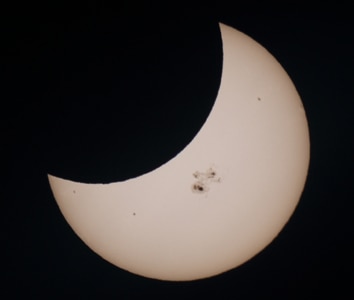Create a free profile to get unlimited access to exclusive videos, sweepstakes, and more!
Gallery: The Partial Solar Eclipse of October 2014

Yesterday was the last solar eclipse the U.S. will see until August 2017. This was a partial eclipse, so the Sun wasn’t completely blocked by the Moon, but it was still a lot of fun. Judging by my Facebook and Twitter feeds, a lot of folks watched this eclipse and took pictures. I was out on my porch taking shots, too—well over a hundred, though only a few came out.
Some people had far better circumstances than I did, though. I asked for them to send me pictures, and I got a lot! Here are just a few of the ones I received … and I threw in one I took as well. You’ll see why.
All photos below used by permission.
Why not start things off with a classic? Craig Ruff took this shot in Table Mesa using a 10 cm telescope. The detail is great; you can see the brain-grindingly huge sunspot group AR 2192 looming in the middle of the Sun’s face as the Moon blocks a big chunk of solar real estate.
Edward Plumer got an unusual view using an H-alpha filter, which lets through light form warm hydrogen. This accentuates the twisted magnetic fields of the Sun, and you can see a huge filament lying across the Sun like a scar. Compare the visible light image on the left with what you can see using the filter, and you can understand why astronomers like to see things in as many different ways as possible.
Astronomer Alex Parker took this wonderful shot as the Sun set behind the iconic Boulder Flatirons. He said it was a syzygy, an alignment of three objects: the Sun, the Moon, and the Earth itself blocking the Sun as it set.
Astronomer and friend Emily Lakdawalla knew that one part of her house creates a spectrum when sunlight hits it. Sure enough, when the Sun was in the right spot, it threw out this amazing multiple-colored eclipse rainbow. I like how each color is a complete (if somewhat distorted) image of the Sun. I used to work with spectra like this back in my Hubble days … though I never observed the Sun with it.
But I have to add Hubble did observe the Sun, exactly once.
For most of the U.S., the eclipse happened in the late afternoon, so the Sun set mideclipse for a lot of people. Bob Robinson caught it between clouds, illuminating the sky is a glorious red. I like how the foreground is silhouetted, including the tower on the left.
I asked for clever photos, ones you might not expect, and Jonathan Albright delivered: He used binoculars to project the Sun, and it was low enough that his shadow made a cameo in the photo as well.
Sometimes you just get lucky: Doyle Slifer was shooting photos of the eclipse when an airplane made an unexpected appearance. It’s about the same apparent size as the sunspot… but in reality the sunspot is well over ten million times bigger.
And why not: I’ll wrap this up with a shot I took myself. The beginning and end of the eclipse were clear here, but the long middle was cloudy. I waited patiently, then less patiently … and was rewarded when the clouds thinned a bit. I think they added a lot of drama to the picture, especially with the airplane contrail across the bottom. It goes to show you that astronomy (and photography, and especially the two together) is sometimes a waiting game. It’s worth trying, even when it seems like the odds are hopelessly stacked against you.
If there’s a life metaphor to take from that, well, feel free to find it. But patience is something we’ll all need to see the next eclipse around these parts. I’m very much looking forward to it … since it may very well be the very first total solar eclipse I’ll have ever seen.
I think I’ve been patient long enough.
Correction: I orginally misspelled Doyle Slifer's last name. My apologies.


























